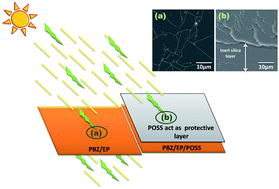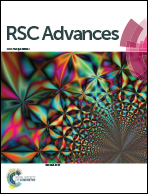The effect of UV radiation on polybenzoxazine/epoxy/OG-POSS nanocomposites
Abstract
Degradation against atomic oxygen (AO), ultra-violet (UV) and vacuum ultra-violet (VUV) radiation has to be controlled in order to maintain the longevity and performance of light weight and high strength nanocomposites used in space and nuclear applications. With this in mind, a new synthetic route has been used to develop a semi-organic precursor, [polyhedral oligomeric silsesquioxane (POSS)] reinforced polybenzoxazine/epoxy (PBZ/EP) nanocomposites. PBZ/EP/POSS nanocomposites have been developed by reinforcing varying weight percentages of (0, 1.0, 3.0, and 5.0 wt%) POSS into 1 : 1 (w/w) ratio of BZ and DGEBA epoxy (EP) matrix via thermal curing. The developed nanocomposites were tested under UV irradiation at the wavelength of 365 nm for a period of one week. The values of tensile strength and morphological behaviour before and after exposure to UV irradiation have been determined in order to assess their radiation resistant behaviour. It was ascertained that the data obtained from the value of tensile strength for 5 wt% POSS reinforced PBZ/EP has changed only to an insignificant extent when compared to that of before UV irradiation. From SEM and XPS analysis, it was observed that a passive inert silica protective layer has been formed after radiation, which protects the composite materials from further deterioration due to radiation. Data from thermal and dielectric studies indicate that the POSS incorporated system possesses better thermal and low dielectric properties than those of the neat PBZ/EP matrix.


 Please wait while we load your content...
Please wait while we load your content...